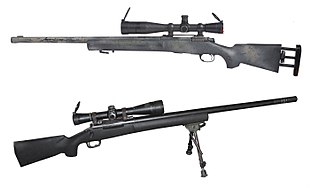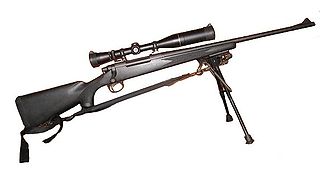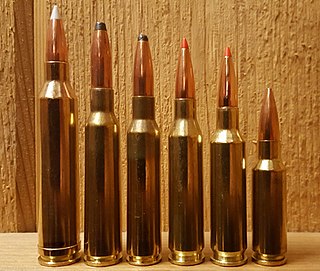
A rifle is a long-barreled firearm designed for accurate shooting and higher stopping power, with a barrel that has a helical pattern of grooves (rifling) cut into the bore wall. In keeping with their focus on accuracy, rifles are typically designed to be held with both hands and braced firmly against the shooter's shoulder via a buttstock for stability during shooting. Rifles are used extensively in warfare, law enforcement, hunting, shooting sports and crime.

In firearm designs, the term single-shot refers to guns that can hold only a single round of ammunition inside and thus must be reloaded manually after every shot. Compared to multi-shot repeating firearms ("repeaters"), single-shot designs have no moving parts other than the trigger, hammer/firing pin or frizzen, and therefore do not need a sizable receiver behind the barrel to accommodate a moving action, making them far less complex and more robust than revolvers or magazine/belt-fed firearms, but also with much slower rates of fire.

The .50 Browning Machine Gun is a .50 in (12.7 mm) caliber cartridge developed for the M2 Browning heavy machine gun in the late 1910s, entering official service in 1921. Under STANAG 4383, it is a standard service cartridge for NATO forces as well as many non-NATO countries. The cartridge itself has been made in many variants: multiple generations of regular ball, tracer, armor-piercing (AP), incendiary, and saboted sub-caliber rounds. The rounds intended for machine guns are made into a continuous belt using metallic links.

A sniper rifle is a high-precision, long-range rifle. Requirements include high accuracy, reliability, and mobility, concealment, and optics, for anti-personnel, anti-materiel and surveillance uses by military snipers. The modern sniper rifle is a portable shoulder-fired rifle with either a bolt action or semi-automatic action, fitted with a telescopic sight for extreme accuracy and chambered for a high-ballistic performance centerfire cartridge.

The .338 Lapua Magnum is a rimless, bottlenecked, centerfire rifle cartridge. It was developed during the 1980s as a high-powered, long-range cartridge for military snipers. It was used in the War in Afghanistan and the Iraq War. As a result of this, it has become widely available.
Savage Arms is an American gunmaker based in Westfield, Massachusetts, with operations in Canada. Savage makes a variety of rimfire and centerfire rifles, as well as Stevens single-shot rifles and shotguns. The company is best known for the Model 99 lever-action rifle, no longer in production, and the .300 Savage. Savage was a subsidiary of Vista Outdoor until 2019 when it was spun off.
The Accuracy International Arctic Warfare rifle is a bolt-action sniper rifle designed and manufactured by the British company Accuracy International. It has proved popular as a civilian, police, and military rifle since its introduction in the 1980s. The rifles have some features that improve performance in very cold conditions without impairing operation in less extreme conditions.

The Remington Model 700 is a series of bolt-action centerfire rifles manufactured by Remington Arms since 1962. It is a development of the Remington 721 and 722 series of rifles, which were introduced in 1948. The M24 and M40 military sniper rifles, used by the US Army and Marine Corps, respectively, are both based on the Model 700 design.

The Barrett M82 is a recoil-operated, semi-automatic anti-materiel rifle developed by the American company Barrett Firearms Manufacturing.

The PGM 338, also known as the PGM .338 LM or PGM Mini-Hecate .338, is French sniper rifle from the early 1990's. It uses the .338 Lapua Magnum (8.6×70mm) cartridge, which remains supersonic up to a range of 1200–1500 m depending on the exact ammunition type and environmental conditions.

The Bor is a Polish bolt-action 7.62×51mm NATO and .338 Lapua Magnum caliber sniper rifle. The weapon received the code name Alex during development, after the name of the lead designer Aleksander Leżucha, creator of the 12.7×99mm NATO Wilk anti-materiel rifle. After the development phase, the rifle received the military designation 'Bor'.
The SAKO TRG is a bolt-action sniper rifle line designed and manufactured by Finnish firearms manufacturer SAKO of Riihimäki. It is the successor to the SAKO TR-6 target rifle, and thus the letter G within the rifle's name is meant to represent number 7.

The DSR-1 is a compact bolt-action sniper rifle designed, manufactured and marketed by the German company DSR-Precision GmbH and was also marketed by the German company AMP Technical Services as a specialized sniper rifle for police sharpshooters. It has been adopted by the German counter-terrorist unit GSG 9, as well as by other European special police units and agencies.
The Barrett M90 is a bolt-action, bullpup rifle chambered in .50 BMG. It was designed and manufactured by Barrett Firearms Company. In 1995, Barrett stopped production of the M90, and replaced it with the M95.
The Desert Tech Stealth Recon Scout (SRS) is a bolt-action sniper rifle developed by the Utah-based firearm manufacturer Desert Tech. It was unveiled at the 2008 SHOT Show. It is known for its bullpup design.

The 6.5mm Creedmoor (6.5×48 mm), designated 6.5 Creedmoor by SAAMI, 6.5 Creedmoor by the C.I.P. or 6.5 CM or 6.5 CRDMR for short, is a centerfire rifle cartridge introduced by Hornady in 2007. It was developed by Hornady senior ballistics scientist Dave Emary in partnership with Dennis DeMille, the vice-president of product development at Creedmoor Sports, hence the name. The cartridge is a necked-down modification of the .30 Thompson Center.

The APR is a bolt-action sniper rifle designed by the Thun-based Brügger & Thomet in 2003 as an evolution of the French PGM Précision.
The C14 Timberwolf MRSWS is a bolt-action sniper rifle built by the Canadian arms company PGW Defence Technologies Inc. In 2005 they won the contract to supply the Canadian Forces Land Command with the C14 Timberwolf MRSWS for $4.5 million.
The Savage 110 BA is a bolt-action sniper/tactical rifle manufactured by Savage Arms. The rifle is designated with an "LE" code; "Law Enforcement". All 110 BA series rifles are configured with AccuTrigger, matte-blued barreled action, fluted heavy free-floating barrel, muzzle brake, oversized bolt handle, external box magazine, magpul adjustable stock, adjustable pistol grip, and three swivel studs for sling and bipod mounting.
The Modular Sniper Rifle, or MSR, is a bolt-action sniper rifle developed and produced by Remington Arms for the United States Army. It was introduced in 2009, and was designed to meet specific United States Army and USSOCOM Precision Sniper Rifle requirements. The MSR initially won the PSR competition, and was called the Remington Mk 21 Precision Sniper Rifle in U.S. military service. However, it was then decided that the Mk 21 did not conform to SOCOM requirements at the time in 2018, and the program was re-competed with the Barrett MRAD selected in 2019 as the Mk 22 Advanced Sniper Rifle solution.